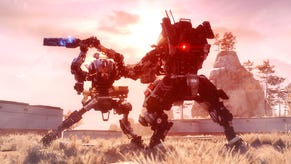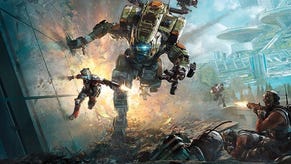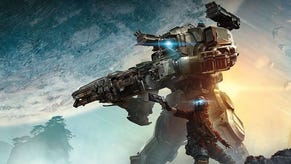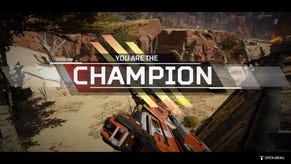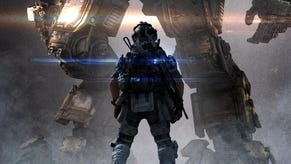Titanfall 2's buddy story is a very human kind of tragedy
Trust me.
We're going to be talking about the entire story of Titanfall 2 here, so be warned - there will be spoilers for the whole game, up to and including the ending.
It's been a good year for companions in games - different kinds of companions. Watching colleagues play The Last Guardian a few weeks back, I was prepared for Trico to behave like a pet. He seemed stubborn, unwilling to follow directions the first time he heard them, but with enough give to suggest that eventually he'd get there. A bit wild, a bit tame, not unlike a housecat.
Now that I've spent a little time with the game, however, I can see that there's much more to him. The opening credits sequence explained to me that I wasn't just going to be dealing with an upscaled cat at all. I was going to be dealing with a mythical beast, and I wasn't prepared for that. Within thirty seconds of picking up the controller I realised that presuming to control Trico was a mistake. He's not a pet, almost an equal. I can understand what he's doing, but not always why he's doing it. At his core, he's daringly unknowable. In a way, it almost feels like you're his companion character.
So if The Last Guardian appears to be about pets, but turns out to be about something quite different, what of Titanfall 2? On the surface, Titanfall 2 is about tools. You've seen everything before. You can call a spade a spade, or a sniper rifle a sniper rifle. Sure, it fires two bullets instead of one, or alternates between two barrels when firing, but you know a submachine gun when you see one. Beyond that, you're given a double jump, perhaps the most archaic of movement tools in video games.
And then you have your mech. Your Titan. Each one of these is to help Titanfall's pilots do their jobs better.To kill and to stay alive. None of these giant metal beasts would have purpose without you. They're items, consumables, killstreaks. They're things. Toys even. Captain Lastimosa, training you in the game's tutorial, turns to you and makes this idea explicit. "Here's one more thing. You're going to love it." It's practically Christmas. You're about to call your own Titan, and then the simulation ends.
And yet, when you meet Titan BT-7274 for the first time in the main campaign that lies beyond the tutorial, it's all very different. You've just lost your first major battle with the Frontier Militia, and everybody you dropped to the planet with is dead. Captain Lastimosa, who minutes ago was training you, bleeds out while you stand over him. His final commands? He wants you to take his pilot suit - and his Titan. BT-7274 is yours, bound by neural-link, and you're immediately off to help repair him. He needs three batteries to get him back into fighting order, and again, it's like you're fixing a vehicle. It's not far from a typical fetch quest. BT gives you basic guidance, but despite knowing your name, he never uses it. He never refers to you as Jack or Pilot Cooper. It's always just Pilot, and it feels distancing, a computer talking to an operator.
BT - as you call him - is governed by three protocols that flash up on your screen, and that are recited to you once again as you go into your first fight as a team. These are very similar to Asimov's three laws of robotics, and it follows that they're in order of importance.
1. Link with the Pilot
2. Uphold the Mission
3. Protect the Pilot.
These are hard-coded into who BT is, and indicate that he'll do whatever it takes to keep you alive. While Titans previous to BT are used as tools, the Vanguard-class Titans, of which he is the first, are designed to be lifelong comrades, so an emphasis is placed on building a connection between these machines and their pilots. You don't have time to ponder this, however, as you're thrown into a what amounts to another tutorial - battle against enemy pilots and their own Titans. Afterwards, BT mentions that your combat efficiency rating has increased. This is when I first picked up on a central theme of the game - that BT would be actively working to make us into a more cohesive single unit.
Later, in the third level of the game, BT is caught in a loading lift's claws as the IMC - the baddy faction - captures him for experimentation. He yells for your help, but he does so in a way that I only picked up on in my second playthrough. Specifically, he yells for Cooper's help. You're no longer just "Pilot", and being referred to by name instantly changes something in the relationship. You're no longer just BT's operator, you're his comrade.
Further on still, you're faced with a huge gap you have to cross, and the only way to do so is for BT to throw you to the far bank. You're not certain about it, but BT asks you to trust him. Trust, something that machines can't have any concept of, can they? This humanises BT, but it also demonstrates the neural connection between pilot and Titan getting stronger. BT is beginning to emote like Jack. During the same sequence, Jack falls quite a distance, only for BT to catch him. Jack gives him a thumbs up, which BT quizzically returns. A lovely touch.
And the game never forgets those rules - the protocols that give BT's world its structure. They come back into play, in fact, almost out of nowhere, during the final level, in which you're hunting for a vast enemy McGuffin. Towards the end of this sequence, you're ambushed, and BT is severely damaged as a result. He asks you to trust him once again, and risks everything to save his pilot, again putting Protocol 3 above all else. He asks you to pop open a secret compartment in his head, containing a Smart Pistol and his braincore, essentially destroying himself in the process. Jack argues against this at first, but BT-7274 almost shouts back at him: "Protocol 3: I will not lose another pilot!" It's tragic, and a little perverse: BT will sacrifice himself to keep you alive, and has no option other than to do so. You escape the ship you've been taken to, and you're told, for the first time in the campaign, to call in your Titan. You call it in, and when it lands, it's that Titan you called during the tutorial, the Titan that never arrived. You slot BT's braincore in and hear the words: "Hello, Jack." This is the first time BT's called you by your first name, and after the trauma of watching him die in front of you, it's a very welcome phrase to hear.
It's in this climax that the three protocols really reveal their depths. You've won your final boss fight, but BT has taken some serious damage in the process. He asks for your help, saying that his automotive controls are damaged, and he needs you to pilot him. It's at this point that the first protocol flashes up: "Link to The Pilot". The McGuffin weapon you've been trying to destroy is about to fire, and the only way to stop it is through detonating a bomb inside it. BT has realised this, and says that, by trusting him, you can detonate the core inside him, and both escape to fight on.
'Protocol 2: Uphold the Mission". You load yourself into a catapult. and you're given a dialogue option once again. One option is "We got a way out of this, BT?" and BT almost dodges the question by answering "Calculating". As you're fired into the weapon, he reaches inside his body, and says, "Trust me," for the third and final time. It's right then that the third protocol flashes up, and you realise what is happening. "Protocol 3: Protect the Pilot." BT sacrifices himself to protect you, and complete the mission.
It's at this point that you realise the tragedy of BT-7274. Throughout the game, you experience trying moments, jokes, terror and success with him. You travel through time, dismantle a group of bloodthirsty mercenaries, and become all that you have ever wanted to be. You've bonded, and become a lot more than you were at the beginning of the game, a lowly rifleman who dreamed of piloting a Titan.
And along the way, BT has learned from you: his mannerisms, the way that he communicates, they all come from the way that your character talks to him. It's heartbreaking that all of this is from the neural link between the two of you, and that everything you've taught BT is ultimately a product of his programming. There was never any true personality, just mimicry. Despite all you've gone through, and all the personality you've given him, BT-7274 is still just a robot, and he still has to follow his three laws.






